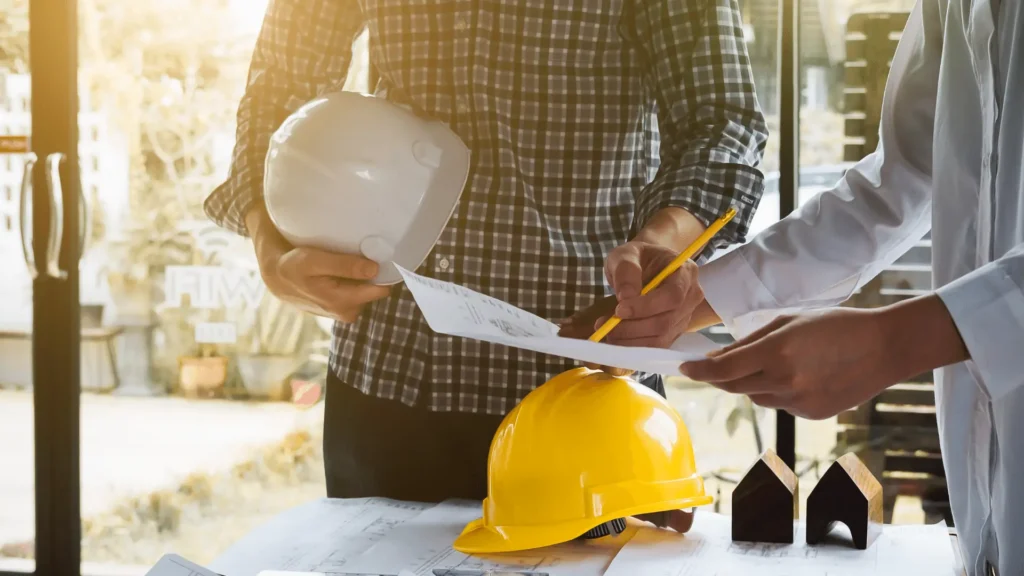In the fast-paced world of construction, maintaining a commitment to quality and safety is not just a responsibility, but a necessity. Construction professionals strive to deliver excellence in every project, and finding effective ways to showcase their dedication is imperative.
Enter photography, a powerful tool that captures the essence of a construction project while highlighting the meticulous attention to detail and unwavering focus on safety. This article explores the benefits of documenting building excellence through photography, shedding light on how this practice can elevate the reputation of construction companies, enhance project management, and foster better communication with clients.
Let’s delve into the world of photography and discover how it truly embodies the essence of commitment to quality and safety in every shot.
Key Takeaways
- Commitment to quality and safety is crucial for the success and reputation of construction companies.
- Documenting building excellence through photography provides a visual approach to capturing progress, quality, and safety.
- Photography can be used to enhance safety measures on construction sites by capturing potential hazards and monitoring the use of personal protective equipment.
- Quality documentation in construction promotes transparency, accountability, and trust among stakeholders.
The Importance of Commitment to Quality and Safety
Commitment to quality and safety is paramount in any industry, especially in the field of construction and building excellence. Ensuring that projects are completed to the highest standards is not only crucial for the success and reputation of the company, but it also plays a significant role in the well-being and satisfaction of the clients. The importance of promise to quality and safety cannot be overstated, as it directly affects the durability, functionality, and overall value of the structures being built.
When it comes to construction and building, there are numerous risks and hazards that need to be carefully managed. From working at heights to handling heavy machinery and hazardous materials, construction sites can be dangerous environments. A strong promise to quality and safety means implementing robust safety protocols and procedures, providing workers with the necessary training and equipment, and regularly monitoring and enforcing compliance.
A commitment to quality and safety also extends to the materials and methods used in construction. Using high-quality materials that meet industry standards ensures the longevity and reliability of the structures. Additionally, employing skilled and experienced workers who adhere to best practices and follow safety guidelines is essential for maintaining quality and preventing accidents.
Documenting Building Excellence: A Visual Approach
Using photography as a powerful tool, documenting building excellence provides a visual approach to capturing the progress, quality, and safety of construction projects. This method allows stakeholders to visually witness each stage of the project, creating a sense of transparency and inclusivity. By documenting building excellence through photography, the audience can experience a strong sense of belonging as they witness the transformation of a mere blueprint into a tangible structure.
Here are three ways in which documenting building excellence through photography evokes emotion in the audience:
- Inspiration: High-quality photographs showcasing the progress and quality of the construction project can inspire the audience by highlighting the dedication and craftsmanship involved in creating a remarkable structure.
- Assurance: By visually documenting safety measures, such as the use of protective gear, sturdy scaffolding, and proper signage, photography assures the audience that the construction site adheres to strict safety protocols, prioritizing the well-being of workers and the public.
- Pride: Sharing photographs of completed building projects instills a sense of pride in the audience, as they witness the successful realization of a vision and the positive impact it has on the surrounding community.
Through the visual documentation of building excellence, photography serves as a powerful medium to evoke emotion, foster a sense of belonging, and demonstrate the commitment to quality and safety in construction projects.
Enhancing Safety Measures Through Photography
To further promote safety and ensure compliance with industry standards, photography can be utilized as a valuable tool in enhancing safety measures on construction sites. By capturing images of potential hazards, workers can have a visual reference of safety protocols and precautions that need to be taken. These images can serve as a reminder of the importance of following safety procedures and can also be used for training purposes, ensuring that all workers are aware of potential risks and how to mitigate them.
Photography can also be used as a means of documenting safety inspections and audits. By visually recording the condition of equipment, machinery, and work areas, any issues or deficiencies can be identified and addressed promptly. This not only promotes a safer working environment but also helps in maintaining compliance with regulatory requirements.
In addition, photography can be used to monitor the use of personal protective equipment (PPE) on construction sites. By capturing images of workers wearing appropriate safety gear, it can be ensured that all workers are adhering to the necessary safety measures. This visual documentation can serve as proof of compliance and can be invaluable in the event of an incident or accident investigation.
The Benefits of Quality Documentation in Construction
Quality documentation plays a crucial role in the construction industry, providing a comprehensive and reliable record of project details, progress, and outcomes. It serves as a vital tool for maintaining accountability, ensuring compliance with regulations, and enhancing communication among all stakeholders involved in the construction process.
Here are some key benefits of quality documentation in construction:
- Accuracy and Precision: Quality documentation captures the intricate details of a construction project, including specifications, plans, and measurements, ensuring that all aspects are accurately recorded. This level of precision helps to minimize errors, delays, and misunderstandings, leading to more efficient and successful project outcomes.
- Transparency and Accountability: By documenting every stage of the construction process, from design to completion, quality documentation promotes transparency and accountability. It allows all parties involved, including contractors, architects, and clients, to have a clear understanding of the project’s progress, ensuring that everyone is on the same page and can address any issues promptly.
- Knowledge Transfer and Continuity: Quality documentation serves as a valuable knowledge transfer tool, enabling future reference and learning from past experiences. It ensures that vital information about construction techniques, materials, and methodologies is preserved, facilitating continuity in future projects and promoting the growth and development of the construction industry as a whole.
Building Trust Through Safety Documentation
Photographic evidence of safety measures implemented throughout the construction process is a powerful tool for building trust and instilling confidence in stakeholders. When stakeholders, such as clients, investors, and regulatory authorities, see clear documentation of safety precautions taken on a construction site, they are more likely to have faith in the project’s overall quality and success.
By capturing images of safety equipment, signage, and protocols being followed, construction professionals can demonstrate their commitment to the well-being of workers and the community.
Safety documentation through photography provides tangible proof of adherence to safety standards and regulations. It allows stakeholders to visually observe the implementation of safety measures and understand that their concerns are being taken seriously. For example, photographs can capture the proper use of personal protective equipment (PPE) by workers, the presence of safety barriers or scaffolding, and the correct handling of hazardous materials. These images can be shared with stakeholders during project updates, meetings, or presentations, reinforcing the message that safety is a top priority.
Moreover, safety documentation through photography fosters a sense of transparency and accountability. It shows that construction professionals are not just talking about safety but are actively documenting and monitoring it. This level of detail-oriented approach cultivates trust among stakeholders, as they feel included and informed about the project’s progress. It also demonstrates a commitment to open communication and collaboration, which are essential for building strong working relationships.
Tips for Effective Photography in Construction Projects
When documenting construction projects through photography, it is important to employ effective techniques that capture the details and essence of the site. By following these tips, you can ensure that your photographs effectively showcase the construction project and convey the message of quality and safety:
- Choose the right angles: Experiment with different angles to find the one that best highlights the key elements of the project. Capture shots that showcase the scale, design, and intricacies of the construction.
- Pay attention to lighting: Lighting can greatly impact the quality of your photographs. Take advantage of natural light whenever possible and avoid harsh shadows. Consider the time of day and adjust your shooting schedule accordingly.
- Focus on the details: Construction projects involve numerous components and details. Capture close-up shots to emphasize the craftsmanship and attention to detail. Showcasing these details will not only demonstrate the commitment to quality but also engage the audience emotionally.
Frequently Asked Questions
What Are Some Key Factors That Contribute to a Commitment to Quality and Safety in Construction Projects?
Key factors that contribute to a commitment to quality and safety in construction projects include rigorous inspections, adherence to safety protocols, effective communication, skilled workforce, and the use of advanced technology for documentation and monitoring.
How Does Documenting Building Excellence Through Photography Enhance Safety Measures?
Documenting building excellence through photography enhances safety measures by providing a detailed visual record of construction processes, identifying potential hazards, and promoting compliance with safety protocols. This documentation enables proactive risk management and fosters a culture of safety on construction sites.
What Are the Benefits of Quality Documentation in the Construction Industry?
Quality documentation in the construction industry provides numerous benefits. It allows for accurate record-keeping, facilitates effective communication, aids in identifying and addressing issues, ensures compliance with regulations, and enhances safety measures by providing a visual record of building excellence.
How Does Safety Documentation Help in Building Trust With Clients and Stakeholders?
Safety documentation plays a crucial role in building trust with clients and stakeholders. By documenting safety measures, incidents, and compliance, it demonstrates a commitment to ensuring their well-being and emphasizes the organization’s dedication to quality and safety.
What Are Some Tips for Effectively Using Photography in Construction Projects?
To effectively use photography in construction projects, it is important to consider factors such as lighting, angles, and composition. Capturing key milestones, documenting progress, and highlighting quality workmanship can enhance communication, provide visual evidence, and contribute to the overall success of the project.
Conclusion
In conclusion, documenting building excellence through photography is a valuable tool for construction professionals to showcase their commitment to quality and safety. By capturing every aspect of a construction project, from design to completion, photography provides a visual record that highlights the dedication to craftsmanship and adherence to safety standards. This documentation not only enhances the reputation of construction companies but also serves as a valuable tool for project management and client communication. Overall, photography offers a comprehensive and tangible representation of a project’s promise to quality and safety.
You May Also Like:


